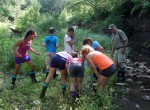Small feet encased in rubber boots splash through the water of Kings Creek on the Konza Prairie in northeast Kansas. A group of 10-year olds are exploring the creek and one of them, Hailey, has just found a frog. I move up to the group of girls to see what they have. Hailey proudly shows me her prize, a tiny cricket frog. I identify the frog for them, aware that the official name of this guy, a Blanchard’s cricket frog, doesn’t really mean much to them. What means something is that they saw it, they caught it, and they’re getting to touch it. That is cool.
At the head of the group is Greg Adams, a new docent—trained volunteer who leads tours, usually at a museum, but here the museum is the prairie–at the Konza Prairie (KNZ) Long Term Ecological Research (LTER) site. Greg has flexible hours at work, which allows him to participate in some of the Konza educational programs. In the middle of the group of kids is Greg’s wife, Jan. Jan moved to Kansas from Ohio where she was an elementary school teacher for 30 years.
It’s clear that Greg and Jan are having just as much fun as the kids. They have their boots on too and are finding snakes, frogs, and algae right along with the kids. What one might not realize is that none of this would be possible without volunteer docents like Greg and Jan Adams.
The Konza LTER docent program began in the early 1990’s to address the constant requests KNZ researchers were getting from the public and surrounding school districts for tours and guided hikes. It became apparent that help was needed and the nascent docent program was born. A small group of intrepid volunteers (many of them Kansas State University retired faculty) learned about the geology, history, biology, and ecology of the area and began to lead tours to share this information. In 2012, 5,695 people (including 2,826 students) visited KNZ and participated in a docent-led program.
The current docent population numbers over 200 people, with approximately 60 of them being active in educational programs. New docents are recruited every spring and a Saturday-morning training program teaches them the same things their predecessors learned: what makes Konza Prairie special and why people should care about it.
This year we tried something new: we combined the docent training program with the training for the Kansas Master Naturalist (KMN) program. Master Naturalists learn the same things the docents do, the biology of mammals, birds, plants, insects as well as geology, ecology and climatology but on a larger, state-wide scale. KMN-trained volunteers are valuable throughout the state at over 100 different sites where they share their time and knowledge with visitors from all over the world.
The KNZ docents are by nature a curious bunch and were eager to become Master Naturalists. At their urging we began offering the KMN and docent training together and had a wonderful result. We got new docents who are also now Kansas Master Naturalists, while the existing docents gained a greater understanding of the natural world beyond the borders of Konza Prairie.
Training docents and Master Naturalists is part of our larger plan to encourage the human members of our ecosystem (whether they be kids or adults) to better understand this system and the importance of it in our daily lives. It mirrors our philosophy of understanding the natural world:
1. See it (e.g. see the hawk on the power line, or the wildflower blooming)
2. Appreciate it
3. Understand it
4. Protect it
If people don’t see what’s in front of them there’s little hope they’ll see any value in it or the need to protect it. KNZ docents bridge that gap by not only showing people what is in front of them, but also explaining why that organism is there and its role in the system.
For children, the mission is a little different. By visiting and exploring a natural place, kids become part of their environment. It gives them a chance to learn their “sense of place”. In Konza, they realize that they, too, belong to the prairie and can play a role in ensuring its future. That is an invaluable lesson and one that is taught over and over again at KNZ by our volunteer team of docents.

 Enlarge this image
Enlarge this image